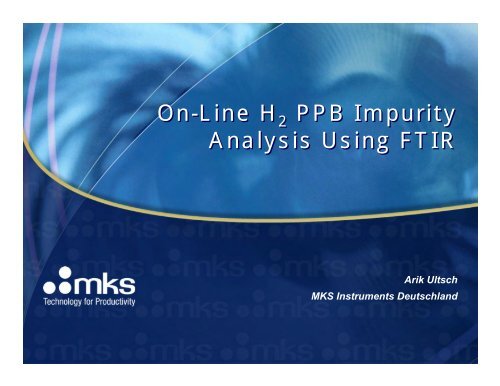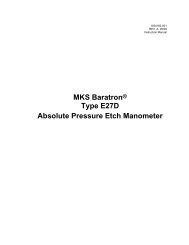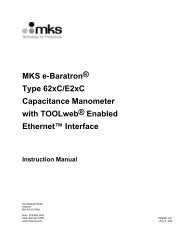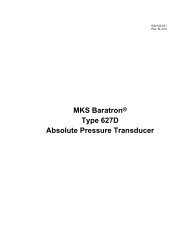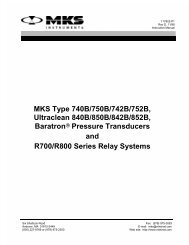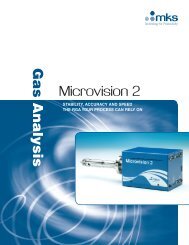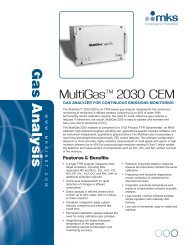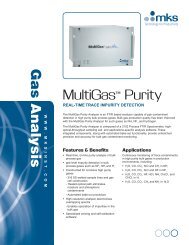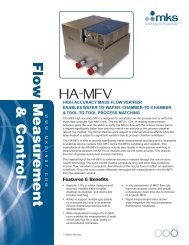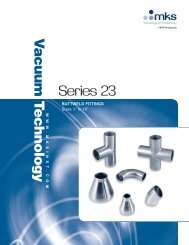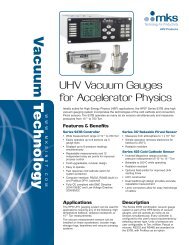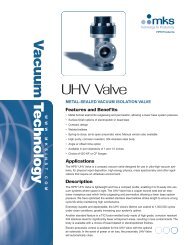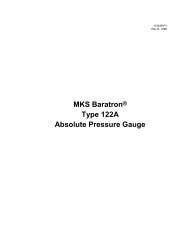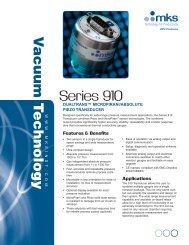On-Line H2 PPB Impurity Analysis Using FTIR - MKS Instruments, Inc.
On-Line H2 PPB Impurity Analysis Using FTIR - MKS Instruments, Inc.
On-Line H2 PPB Impurity Analysis Using FTIR - MKS Instruments, Inc.
Create successful ePaper yourself
Turn your PDF publications into a flip-book with our unique Google optimized e-Paper software.
<strong>On</strong>-<strong>Line</strong> H <strong>PPB</strong> <strong>Impurity</strong><br />
2 <strong>Impurity</strong><br />
2<br />
<strong>Analysis</strong> <strong>Using</strong> <strong>FTIR</strong><br />
Arik Ultsch<br />
<strong>MKS</strong> <strong>Instruments</strong> Deutschland
Background<br />
� Volatile fossil fuel prices have created interest in<br />
Hydrogen as a new energy source for the<br />
auto industry<br />
� Impurities in H 2 fuel directly affect the longevity of the<br />
combustion or fuel cell engine<br />
� Regulatory agencies have initiated<br />
an H 2 quality threshold at the<br />
ppb level<br />
� <strong>FTIR</strong> spectroscopy is the<br />
most viable method of providing<br />
ppb level H 2 impurity detection<br />
on-site at the pump
H 2 <strong>Impurity</strong> <strong>Analysis</strong>: Content<br />
� Fuel cell principle<br />
� Determining the effect of impurities on fuel cells<br />
– How much can be tolerated?<br />
– Is the effect reversible?<br />
– Effects of impurities<br />
� Sulfur (H 2S, COS), ammonia, CO, CO 2, H 2O<br />
– Impurities from H 2 Fuel as well as Air Feed<br />
� Cell <strong>Analysis</strong> by Air Liquide R&D Center USA<br />
� Robert Benesch, Tracey Jacksier, and Sumaeya Salman<br />
� <strong>FTIR</strong> Validation for H 2 impurity detection<br />
– Method detection limits for:<br />
� Multiple components<br />
� Different <strong>FTIR</strong> detector ranges tested
Fuel Cell Principle<br />
� Fuel cells generate electricity from a simple<br />
electrochemical reaction in which oxygen and<br />
hydrogen combine to form water<br />
� Anode<br />
– Porous carbon coated with tiny particles of platinum (Pt)<br />
– Pt acts as a catalyst to form ions<br />
(2H 2 => 4H + + 4e - )<br />
� Proton Exchange Membrane (PEM)<br />
– Allows positively charged<br />
ions to travel through<br />
� Cathode<br />
– Forms oxygen atoms<br />
– Oxygen and hydrogen<br />
combine to form water<br />
(O 2 + 4H + + 4e - => 2H 2O)
<strong>Impurity</strong> Effects on Cell Voltage<br />
� Decrease in performance<br />
– Affect different physical and chemical processes<br />
� Removal of impurity<br />
– Cell Performance: recoverable or non-recoverable
The Fuel – Hydrogen and Air<br />
� Hydrogen<br />
– Introduced to anode side of fuel cell<br />
� Reducing environment<br />
– Dependant upon production method<br />
� Typical methods<br />
- Biological – fermentation, anaerobic digestion<br />
- Electrochemical – electrolysis of H 2 O<br />
- Thermal – reforming, gasification<br />
� Steam Methane Reforming (SMR)<br />
- 95% of US H 2 production<br />
- He, N 2 , CO, H 2 S, NH 3 , CH 4 …<br />
� Air<br />
– Introduced to cathode side of fuel cell<br />
� Oxidizing environment
Sources of Impurities<br />
� Carbon Monoxide in H 2<br />
– Reported Mechanism*<br />
� Physical adsorption onto fuel cell catalyst<br />
� CO absorbs onto Pt site blocking H 2 adsorption<br />
CO + Pt ⇔Pt⋅CO<br />
g<br />
s<br />
* J. Baschuyuk and X. Li, “Carbon Monoxide Poisoning of Proton Exchange Membrane<br />
Fuel Cells”; Int. J. Energy Res. 2001, 25; 695-713<br />
ads<br />
Pt g<br />
+ −<br />
⋅COads+ <strong>H2</strong>O→Pts<br />
+ CO2<br />
+ 2H<br />
+ 2e
CO Effect on Fuel Cell<br />
1.0 and 4.5 ppm CO in H 2<br />
9.2 ppm CO in H 2
Sources of Impurities<br />
� Ammonia in H 2<br />
– Reported Mechanism*<br />
� Concentration and exposure dependant<br />
� Short-term exposure of trace concentrations<br />
(~40ppm)<br />
- Non-Reversible<br />
- Mainly effects the Membrane structure<br />
* F. Uribe, S. Gottesfeld, T. Zawodzinski, “Effect of Ammonia as Potential Fuel <strong>Impurity</strong> <strong>On</strong> Proton<br />
Exchange Membrane Fuel Cell Performance” J. Electrochemical Society, 2002, 149 (3) A293-296
NH 3 Effects on Fuel Cell<br />
pure H 2<br />
0.5, 1.0 ppm NH 3 in H 2<br />
No Effect<br />
9.0, 44.7 ppm NH 3 in H 2<br />
9.0 Non - Reversible<br />
44.7 Non - Reversible
Summary of Impurities Tested<br />
<strong>Impurity</strong> Electrode<br />
Lowest Test<br />
Conc (ppm)<br />
Highest Test<br />
Conc (ppm)<br />
% Decrease<br />
at Lowest<br />
Conc<br />
Typical Air Sample: (maximum hourly concentration detected at<br />
EPA testing sites in Houston and Chicago area in 2005):<br />
CO [3 ppm], NO [0.65 ppm], SO 2 [0.137 ppm]<br />
% Decrease<br />
at Highest<br />
Conc<br />
CO anode 0.52 9.2 5 >58<br />
<strong>H2</strong>S anode 0.10 2.0 not detected >58<br />
NH3 anode 0.50 44.7 not detected 14.7<br />
CO cathode 0.40 68.6 not detected not detected<br />
SO2 cathode 0.07 4.8 3 40<br />
NO2 cathode 0.025 2.86 not detected 20
Current H 2 Fuel Cell Specification<br />
SAE J2719<br />
Property Value Unit Limit<br />
1 Ammonia 0.1 ppm v/v Maximum<br />
2 Carbon Dioxide 2 ppm v/v Maximum<br />
3 Carbon Monoxide 0.2 ppm v/v Maximum<br />
4 Formaldehyde 0.01 ppm v/v Maximum<br />
5 Formic Acid 0.2 ppm v/v Maximum<br />
6 Helium 300 ppm v/v Maximum<br />
7 Hydrogen Fuel Index 99.97 % (a) Maximum<br />
8 Nitrogen and Argon 100 ppm v/v Maximum<br />
9 Oxygen 5 ppm v/v Maximum<br />
10 Particulate Concentration 1 µg/L@NTP (b) Maximum<br />
11 Particulates Size 10 µm Maximum<br />
12 Total Gases 300 ppm v/v (c) Maximum<br />
13 Total Halogenated Compounds 0.05 ppm v/v Maximum<br />
14 Total Hydrocarbons 2 ppm v/v (d) Maximum<br />
15 Total Sulfur Compounds 0.004 ppm v/v Maximum<br />
16 Water 5 ppm v/v Maximum
<strong>FTIR</strong> For H 2 <strong>Impurity</strong> <strong>Analysis</strong><br />
� Real-time analysis at ppb levels<br />
� <strong>FTIR</strong> advantage<br />
– Multiple components analysis with one unit<br />
� Single analyzer for all the impurities except O 2, H 2, Ar, N 2<br />
– High resolution enables speciation between similar molecules<br />
� Butane, Propane, Ethane, Methane, fuel sources, etc.<br />
– Permanent calibration<br />
– <strong>Analysis</strong> performed at various sites<br />
� H 2 production site<br />
� H 2 storage site: gas or liquid cylinders<br />
� At - <strong>Line</strong> analysis at fueling station
Infrared (IR) Spectroscopy<br />
� Based on IR light absorption<br />
– Energy (IR radiation) heats molecule - vibrations and rotations<br />
– The pattern and intensity of the spectrum provides all the information<br />
about gas (type and concentration)
Background and Sample<br />
BACKGROUND (Io)<br />
N 2 Purge 1cm -1<br />
SAMPLE (I)<br />
1000 ppm NH 3 1cm -1<br />
Absorbance = - Log (I/Io)
Absorbance is Proportional to<br />
Concentration<br />
Absorbance = - Log (I/Io)<br />
Absorbance = ε •C •path<br />
FFT of Sample<br />
1000 ppm NH 3 1.0 cm -1
What Can <strong>FTIR</strong> Do?<br />
Hydrogen (<strong>H2</strong>), %<br />
Oxygen (O2), %<br />
Nitrogen (N2), %<br />
Water (<strong>H2</strong>O), %<br />
Component<br />
Hydrogen Sulfide (<strong>H2</strong>S), ppm<br />
Carbon Monoxide (CO), %<br />
Carbon Dioxide (CO2), %<br />
Methane (CH4), %<br />
Non-methane Hydrocarbons, %<br />
Nitric Oxide (NO), ppm<br />
Nitric Dioxide (NO2), ppm<br />
Sulfur Dioxide (SO2), ppm<br />
Product<br />
40-80<br />
0-1<br />
0-10<br />
0-300<br />
0-25<br />
0-25<br />
0-25<br />
0-10<br />
0-10<br />
Low ppm<br />
Low ppm<br />
Low ppm<br />
Exhaust<br />
0-10<br />
0-5<br />
0-80<br />
Low ppm<br />
0-25<br />
0-25<br />
0-25<br />
0-10<br />
0-10<br />
0-100<br />
Low ppm<br />
0-100<br />
� Analyze all components that:<br />
– Are IR active<br />
– Have Dipole Moments<br />
� Examples<br />
– Ammonia, CO, CO 2 , H 2 O,<br />
Hydrocarbons, etc<br />
� Raw Reformed Hydrogen<br />
– Percent level analysis<br />
� Purified Hydrogen<br />
– <strong>PPB</strong> level analysis
<strong>FTIR</strong> Components Used For Test<br />
� Gas Cell<br />
– Stainless steel – path length 5.11 meters<br />
– Metal sealed cell:
16u Cutoff<br />
Ammonia<br />
9u Cutoff<br />
Water<br />
Methane<br />
Ethane<br />
Formic Acid<br />
Formaldehyde<br />
CO2<br />
CO
Method Validation<br />
� EPA Method 40 CFR 136 Appendix B<br />
– Build calibrations on <strong>FTIR</strong><br />
– Estimate a minimum detection limit<br />
– Determine how low a concentration can be<br />
detected with this method
<strong>FTIR</strong> Validation Method for H 2<br />
� Gases validated on <strong>FTIR</strong><br />
– CO, CO 2, CH 4, C 2H 6, NH 3, H 2O, Formaldehyde<br />
and Formic Acid<br />
– All in Balance of H 2<br />
� Gas standards creation<br />
– NIST traceable gas cylinders for gases<br />
� 100 ppm of CO, CO 2 , CH 4 , C 2 H 6 in H 2<br />
– NIST traceable permeation tubes for liquids<br />
� NH 3 , H 2 O, Formaldehyde and Formic Acid<br />
– Blended with H 2<br />
� Purified H 2 (
Method Detection Limits<br />
Contaminant<br />
SAE J2719<br />
Detection<br />
Limits (ppmv)<br />
16u Stirling* 9.2u TE 16u LN2<br />
Ammonia (NH3) 0.10 0.36 0.81 0.02<br />
Carbon Monoxide (CO) 0.20 0.01 0.05 0.01<br />
Carbon Dioxide (CO2) 2.00 0.01 0.01 0.01<br />
Formaldehyde (HCHO) 0.01 0.02 0.02 0.02<br />
Formic Acid (HCOOH) 0.20 0.03 0.02 0.02<br />
Total Hydrocarbons<br />
2.00 0.71<br />
(Reported as C1)<br />
Methane 0.10 0.02 0.02 0.03<br />
Ethane 0.10 0.02 0.05 0.05<br />
Ethylene 0.10 0.03<br />
Water (<strong>H2</strong>O) 5.00 0.40 0.74 0.12<br />
* Signal to noise ratio (SNR) was 1/3 that of 16u LN2 for this test<br />
* However improved SNR to same level as 16u LN2
Acknowledgments<br />
� Fuel cell work<br />
– Air Liquide Research and Technology Center<br />
� Robert Benesch, Tracey Jacksier, Sumaeya Salman<br />
� Method validation / calibration work<br />
– Elutions Design Bureau, <strong>Inc</strong> – Houston, TX<br />
� Scott Thompson<br />
– <strong>MKS</strong> <strong>Instruments</strong> – <strong>On</strong> <strong>Line</strong> Product Group<br />
� Barbara Marshik<br />
– Monetary support for this work<br />
� <strong>MKS</strong> <strong>Instruments</strong><br />
� Shell Global Solutions <strong>Inc</strong>. - Westhollow Technology<br />
Center


